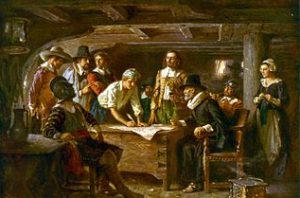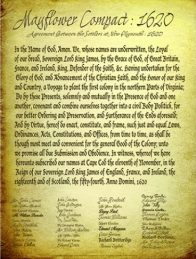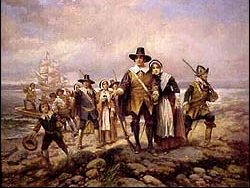 The September 6, 1620 trip to the new world, in which 102 passengers, who had been dubbed Pilgrims by William Bradford, one of the passengers who would become the first governor of Plymouth Colony, was a crowded, grueling trip on the Mayflower to a new life in the New World. The trip was filled with hardship, and sometimes even loss. Nevertheless, the pilgrims knew it had to be taken. The situation actually began in 1606, when a group of reform-minded Puritans in Nottinghamshire, England, founded their own church, that was separate from the state-sanctioned Church of England. This was truly the reason why “Freedom of Religion” is such an important part of our constitution. Many people dispute that fact that our nation was formed on religious principles, but it was, from the very core of the move here.
The September 6, 1620 trip to the new world, in which 102 passengers, who had been dubbed Pilgrims by William Bradford, one of the passengers who would become the first governor of Plymouth Colony, was a crowded, grueling trip on the Mayflower to a new life in the New World. The trip was filled with hardship, and sometimes even loss. Nevertheless, the pilgrims knew it had to be taken. The situation actually began in 1606, when a group of reform-minded Puritans in Nottinghamshire, England, founded their own church, that was separate from the state-sanctioned Church of England. This was truly the reason why “Freedom of Religion” is such an important part of our constitution. Many people dispute that fact that our nation was formed on religious principles, but it was, from the very core of the move here.
On November 11, 1620, the Mayflower anchored at what is now Provincetown Harbor, Cape Cod. Of course, it was mandatory that they scout out the new land to make sure it  was safe before bringing the women and children there. Before going ashore, 41 male passengers…heads of families, single men and three male servants…signed the famous Mayflower Compact, agreeing to submit to a government chosen by common consent and to obey all laws made for the good of the colony. Over the next month, several small scouting groups were sent ashore to collect firewood and scout out a good place to build a settlement.
was safe before bringing the women and children there. Before going ashore, 41 male passengers…heads of families, single men and three male servants…signed the famous Mayflower Compact, agreeing to submit to a government chosen by common consent and to obey all laws made for the good of the colony. Over the next month, several small scouting groups were sent ashore to collect firewood and scout out a good place to build a settlement.
Around December 10, one of these groups found a harbor they liked on the western side of Cape Cod Bay. They returned to the Mayflower to tell the other passengers, but bad weather prevented them from docking until December 18. After exploring the region, the settlers chose a cleared area previously occupied by members of a local Native American tribe, the Wampanoag. The travel weary pilgrims finally prepared to begin their new settlement, Plymouth Colony. The Wampanoag tribe had abandoned the village several years earlier, after an outbreak of European disease. That winter of 1620-1621 was brutal, as the Pilgrims struggled to build their settlement, find food and ward off sickness. They were less than highly successful, because by spring, 50 of the original 102 Mayflower passengers were dead. The remaining settlers made contact with returning  members of the Wampanoag tribe, and in March they signed a peace treaty with a tribal chief, Massasoit. Aided by the Wampanoag, especially the English-speaking Squanto, the Pilgrims were able to plant crops…especially corn and beans…that were vital to their survival. The Mayflower and its crew left Plymouth to return to England on April 5, 1621.
members of the Wampanoag tribe, and in March they signed a peace treaty with a tribal chief, Massasoit. Aided by the Wampanoag, especially the English-speaking Squanto, the Pilgrims were able to plant crops…especially corn and beans…that were vital to their survival. The Mayflower and its crew left Plymouth to return to England on April 5, 1621.
Over the next several decades, more and more settlers made the trip across the Atlantic to Plymouth, which gradually grew into a prosperous shipbuilding and fishing center. In 1691, Plymouth was incorporated into the new Massachusetts Bay Association, ending its history as an independent colony. And the rest, as they say, is history.


Leave a Reply